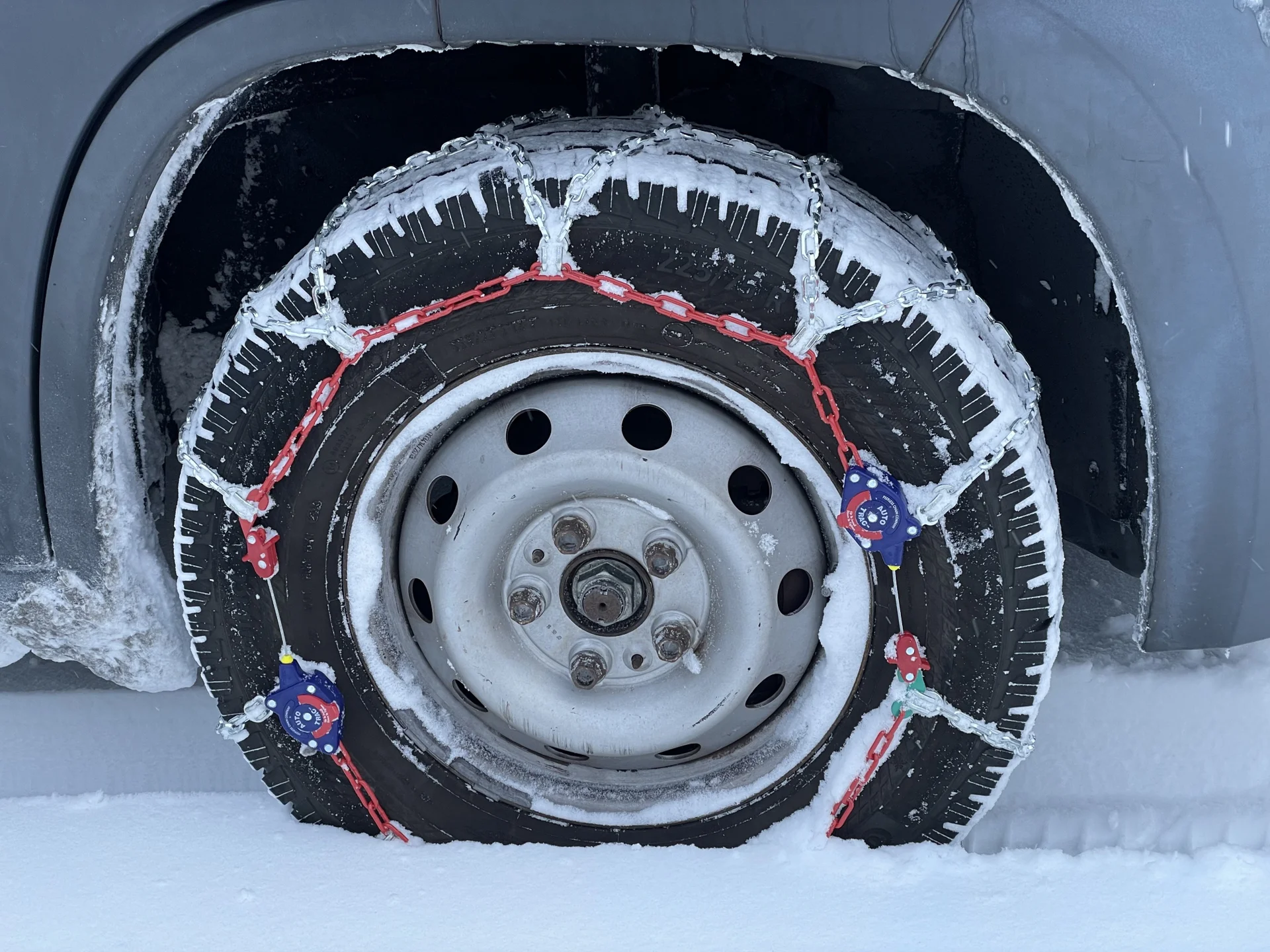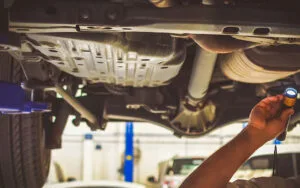If you’ve ever faced a steep, snow-covered hill or an icy mountain pass in winter, you know how quickly a normal set of tires can turn useless. That’s when traction devices like snow chains and snow cables become essential.
But when it’s time to choose between the two, the decision isn’t always clear. Which one works better? What’s easier to install? Which is better for your vehicle? These are common questions—especially if you’ve never used either before.
Picture this: you’re heading up to a ski resort in your 2020 Subaru Outback, loaded with gear and passengers. The roads look manageable at first, but halfway up the mountain, a sign says “Chains Required.”
You pop the trunk, and now you’re asking yourself—did I bring chains or cables? And are they even the right kind for this car?
In this guide, we’ll break it all down clearly, so you can hit the road confidently—no guesswork involved.
What Are Snow Chains?
Snow chains are heavy-duty traction devices that wrap around your tires to provide grip on icy or snowy roads. They’re made from metal links, usually steel, and they dig into snow and ice to help your vehicle maintain traction. Some chains are ladder-style, while others form a diamond or square pattern around the tire.
They’ve been around for over a century and remain one of the most effective ways to get your car moving through tough winter conditions.
What Are Snow Cables?
Snow cables are a lighter, more flexible alternative to traditional chains. Instead of metal links, they use steel cables often coated with a material like rubber or plastic. They wrap around the tires in a similar pattern but tend to be easier to handle and install.
Cables are typically recommended for vehicles that don’t have much space between the tires and the wheel wells—like many modern sedans and crossovers.
How They Work: Chains vs Cables
Both chains and cables improve tire grip by increasing the surface area and friction between the tire and the road. The big difference lies in how aggressively they bite into snow or ice. Chains, with their thicker metal links, dig in deeper. Cables offer more modest grip, but they’re easier on the vehicle and the road surface.
In short:
- Chains = more aggressive traction
- Cables = quicker to install, lighter, and smoother on the road
Pros and Cons of Snow Chains
Pros:
- Strong grip in deep snow and ice
- Durable and long-lasting
- Performs well in mountainous or extreme conditions
- Available in various designs (e.g., diamond pattern for smoother rides)
Cons:
- Heavier and bulkier to carry around
- Takes more time to install (especially in cold or snowy weather)
- Can be noisy and bumpy on clear roads
- May not fit all vehicles due to clearance issues
Pros and Cons of Snow Cables
Pros:
- Lightweight and easier to handle
- Faster installation
- Better suited for vehicles with tight wheel wells
- Smoother and quieter on pavement
Cons:
- Not as much grip as traditional chains
- Wears out more quickly
- Less effective in deep snow or extreme ice
- May not be accepted everywhere as a substitute for chains
When to Use Chains Over Cables
Chains are the go-to option when conditions are truly harsh. If you’re regularly driving through deep snow, icy hills, or off-road areas during winter, chains offer the confidence and traction you need.
They’re also better if you’re hauling a trailer or carrying a heavy load. More traction means better control and braking in challenging conditions.
When Cables Make More Sense
Cables are ideal for people who:
- Live in areas with occasional snow
- Need a temporary traction solution for a ski trip or weekend getaway
- Drive modern vehicles with limited tire clearance
- Want something easy to install in an emergency
They’re also a good backup for people who don’t want to commit to the weight and effort of full chains.
Fitment and Vehicle Compatibility
Before buying either chains or cables, you need to check your vehicle’s owner’s manual. Some cars—especially performance vehicles or those with tight suspension setups—don’t allow snow chains at all. In those cases, cables may be the only option.
You’ll also need to check your tire size. Both chains and cables are sold by tire diameter and width. Using the wrong size can lead to poor performance or even damage.
Installation Differences
Chains generally take longer to install, especially if you’re doing it for the first time. It usually involves laying the chain flat, driving over part of it, then fastening the rest around the tire. Some modern chain designs are easier, with self-tightening mechanisms.
Cables, on the other hand, are quicker. They’re more flexible and lighter, which makes them easier to wrap around the tire. Many people find they can install cables in less than half the time it takes to put on chains.
Pro tip: Practice installing your chains or cables in dry conditions before you actually need them. Doing it for the first time on a snowy roadside is never fun.
Durability and Longevity
If you’re thinking long term, chains tend to last much longer than cables. They’re made from thicker metal and can handle multiple winters if properly maintained.
Cables, while convenient, are more prone to wear. They’re perfect for occasional use but may only last a season or two with frequent use.
So if you’re a regular snow traveler, investing in chains might make more sense.
Road Restrictions and Legal Requirements
In some areas, especially mountainous regions like the Sierra Nevada or the Rockies, road signs may say “Chains Required.” But not all states or provinces accept cables as a substitute.
Important: Always check local chain laws. Some places only accept cables if your vehicle’s manufacturer prohibits chains. Others allow both but specify which axle to install them on.
Ignoring chain requirements can result in fines—or worse, being turned away at chain checkpoints.
Comfort, Noise, and Vibration
Chains are loud. On bare pavement, you’ll hear and feel every link thumping under the tire. They’re rougher to drive with, and they can sometimes shake the car slightly, especially at low speeds.
Cables are much quieter. You’ll still hear a hum and feel some vibration, but it’s noticeably less jarring than chains.
For short distances in rough conditions, chains are tolerable. For mixed or dry roads, cables win in comfort.
Maintenance and Storage
Chains need to be cleaned and dried after each use to prevent rust. If stored wet or muddy, they can corrode quickly. You’ll want to keep them in a storage case or bag in your trunk.
Cables, while less prone to rust, can tangle more easily. They should also be cleaned after use and stored flat if possible to avoid kinks.
No matter what you use, keeping gloves and a kneeling pad in your trunk can make installation and removal a whole lot easier.
Cost Comparison
Cables usually cost less—sometimes as little as half the price of chains. They’re budget-friendly and perfect for occasional use.
Chains cost more up front, but they last longer, so they may be more economical in the long run for regular users.
Prices vary based on brand, tire size, and design. Here’s a general range:
- Cables: $30–$80
- Chains: $60–$150+
Recommendations Based on Vehicle Type
- Compact Cars & Sedans: Go with cables if clearance is tight. Chains may damage wheel wells or suspension.
- SUVs & Crossovers: Either works, but chains provide better traction.
- Trucks & 4x4s: Chains are more durable and reliable, especially if towing.
- Electric Vehicles: Check your owner’s manual—some EVs have low clearance and require specific cable types.
Always confirm compatibility before buying.
Final Verdict: Which Should You Choose?
If you’re looking for strength and traction, and don’t mind taking a little extra time to install them, chains are the better option—especially if you frequently drive in snow or live in a mountainous area.
If you want something lightweight, easy to store, and quick to install for occasional use, cables are the smarter choice. They’re perfect for drivers who may only need them once or twice a year.
There’s no one-size-fits-all answer. Your vehicle, your climate, and how often you encounter snow all play a role in which is best.
Additional Tips for Winter Traction
- Always keep your chains or cables in the car during winter months.
- Practice installing them before your first snowstorm.
- Pair them with winter tires for maximum safety.
- Never exceed the recommended speed (usually 30 mph or less) when using chains or cables.
- Check local road condition reports and chain requirements before heading into snowy areas.
Chains and cables both serve the same purpose: to help your tires grip the road when winter turns nasty. Whether you pick the rugged strength of chains or the convenience of cables depends on how, where, and how often you drive in snow. With the right choice, you’ll be better prepared, safer, and a whole lot more confident when those snowy roads start showing up.




